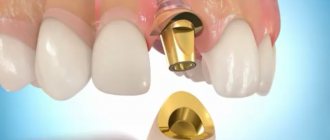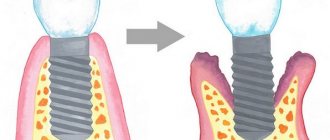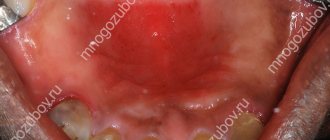The process of dental implantation is associated with a surgical intervention in the human body, during which an implant (a titanium pin simulating a tooth root) is installed in the jawbone, and then a crown is fixed to it.
Although implantation is not new as an effective and safe way to restore lost teeth using artificial roots, some people still consider it a painful procedure and prefer classic prosthetic solutions. Is dental implantation really painful? Let's try to understand this issue.
Why do you need pins at all?
Pins are used in cases where a tooth destroyed by caries or injury cannot be restored in the usual way, that is, by filling a cavity cleared of caries with filling material. This usually happens if treatment is too late, and the disease is so advanced that only thin walls remain of the tooth. In such a situation, the pin serves as a support on which the crown or fixed bridge .
In addition, pins are also used to solve other problems. Thus, the pin often acts as an auxiliary tool when reinforcing a tooth in which the pulp has been removed. Often, pins are also not an independent element, but part of a structure that is made for splinting the dentition in case of periodontal diseases. In this case, the doctor’s task is to “hold” the teeth in the gums.
Installation steps
The installation of pins is carried out only after complete root canal treatment. Treatment using a pin structure consists of the following stages:
- Initial examination of the patient, oral organs;
- Diagnostics (radiography) and development of a treatment plan;
- Anesthesia of the required area of the jaw;
- Preparation of hard tissues, nerve removal;
- Instrumental and medicinal treatment of root canals;
- Filling the root canal system;
- Preparing the space for the pin using special tools;
- Fixing the rod with glue (cement);
- Extension of the crown part of a tooth using filling material or an artificial crown;
- Prescriptions and recommendations for the patient.
Types of pins
- Made from fiberglass, the post quickly became popular among dentists due to its hypoallergenic properties. The material, which does not come into contact with the tissues of the oral cavity, does not rust, does not lose strength over time, and can also be removed if necessary with a minimum of effort.
- The carbon fiber pin is also considered durable and modern. In terms of its characteristics, especially elasticity, it is in many ways similar to natural dentin, that is, tooth tissue, which significantly reduces the likelihood of an unpleasant complication - a root fracture.
- Pins with the complex name “parapulpal” are made from a metal alloy with stainless properties and then coated with polymer. They are not used in the pulp, but serve as additional supporting structures.
- Pins are also made of titanium, ceramic, and metal. In each specific case, the doctor makes a decision on the use of one or another type of pin individually, based on the condition of the patient’s dentition.
- Promotion SGS Implant + crown
Promotion for turnkey dental implantationSGS implant + healing abutment + abutment + crown + work
old price
57 300 ₽
turnkey price, with 100% payment
24 900 ₽
Book an implant
The offer is limited, book the implants on offer in advance. Sign up for a free consultation. Your reservation is valid only after making an advance payment under the Agreement, no later than 10 days from the date of the initial consultation.
- Promotion
Osstem implant + zirconium crown
Promotion for turnkey dental implantation
Osstem implant + healing abutment + abutment + zirconium crown + work
old price
68 400 ₽
turnkey price, with 100% payment
29 900 ₽
Book an implant
The offer is limited, book the implants on offer in advance. Sign up for a free consultation. Your reservation is valid only after making an advance payment under the Agreement, no later than 10 days from the date of the initial consultation.
- Promotion
Astra Tech implant + zirconium crown
Promotion for turnkey dental implantation
Astra Tech implant + gum former + abutment + zirconium crown + work
old price
88 400 ₽
turnkey price, with 100% payment
59 900 ₽
Book an implant
The offer is limited, book the implants on offer in advance. Sign up for a free consultation. Your reservation is valid only after making an advance payment under the Agreement, no later than 10 days from the date of the initial consultation.
- Promotion
Nobel implant + zirconium crown
Promotion for turnkey dental implantation
Nobel implant + healing abutment + abutment + zirconium crown + work
old price
88 400 ₽
turnkey price, with 100% payment
59 900 ₽
Book an implant
The offer is limited, book the implants on offer in advance. Sign up for a free consultation. Your reservation is valid only after making an advance payment under the Agreement, no later than 10 days from the date of the initial consultation.
- Promotion
Straumann implant + zirconium crown
Promotion for turnkey dental implantation
Implant Straumann Roxolid SLActive (
No. 1 in the World! ) + gum former + abutment + zirconium crown + work
old price98 400 ₽
price turnkey price, with 100% payment
59 900 ₽
Book an implant
The offer is limited, book the implants on offer in advance. Sign up for a free consultation. Your reservation is valid only after making an advance payment under the Agreement, no later than 10 days from the date of the initial consultation.
Tags
Fluoridation of teeth for milk teeth for milk teeth for milk teeth for milk teeth for teeth for Silvering of teeth Restoration of teeth for teeth for teeth Prosthetics for milk Prosthetics for Prosthetics for Prosthetics for Treatment of caries Treatment of caries Treatment of pulpitis Treatment of periodontitis Treatment of teeth Treatment of teeth Treatment of caries Treatment of caries Treatment of pulpitis Treatment of periodontitis Doctors Doctors that's why doctors install
prices articles gum braces reviews indications sign up implant whitening promotions summer contacts cyst specialists what work veneers removable contraindications personal children's orthopedics Moscow data our pulpitis professional treatment compliance new flight telephones mandatory
How to install the pin? Does it hurt?
If you have entrusted dental treatment or prosthetics to a doctor from a clinic with a good reputation, there is no need to worry. We are sure that you will not experience any unpleasant sensations. First, the doctor will examine the tooth, decide on the use of a pin, and tell you how the installation will proceed.
If the root canal is filled, it will need to be unfilled to place the pin. This is followed by direct installation and fastening of the pin with a composite material.
Once the material has hardened and the pin is securely fastened, the doctor can begin restoring the shape of the tooth. If a pin is used on a front tooth, you should pay special attention to the restoration so that the shades of the restored tooth and the “neighbors” located next to it match, and the artificial tooth does not stand out from the series due to color.
Life time
Initially unlimited. This means titanium rods can last a lifetime. Only the crown will be subject to periodic replacement. In order to reduce the cost, manufacturers come up with various materials in both directions: increasing, as well as decreasing, quality and cost.
The accuracy of the work done is an additional factor affecting the life of the pin. The distribution of chewing load, position in space, bite, normal jaw pressure and other factors that directly affect the service life depend on the correctness of the calculations.
Which option to choose depends on financial capabilities and specific recommendations of the doctor. You should always remember that the durability of any product depends on its care. If you take good care of the implant, following all the dentist’s recommendations, the pin will last a long time.
An implicit but important parameter influencing this indicator is cost. High-quality materials will cost more. However, strong components at the heart of such products are the key to long-term use and a quiet life.
The article discussed in detail the question: how a dental implant is inserted and screwed in, indications for having it implanted, types of operations with detailed explanations of their stages.
How should I care for a restored tooth with a post inside?
First of all, any tooth, be it artificial or your “native” one, needs high-quality hygiene. Proper regular brushing, dental floss, and irrigator are your daily helpers in maintaining the beauty of your smile.
In some cases, after installing the pin, the patient may experience pain. The first thing to do in this case is to go to the clinic for an x-ray to make sure that the pin was not inserted too deep and did not touch the bone tissue.
If everything is fine with this, most likely the pain is due to the fact that the gum tissue was affected during dental prosthetics , causing it to become inflamed and react to touch. The aching pain usually goes away after a few days, but this does not mean that you should endure it, even if it does not pose any danger to your health. Ask your doctor to prescribe a pain reliever or rinse that can relieve discomfort.
- Promotion
Dental treatment under anesthesia
Promotion for sedation in Moscow!
If you experience: — Severe stress during dental treatment — Fear of the sound of dental instruments — Time-limited visits to the dentist
old price
12 000 ₽
price
5 900 ₽
Free consultation RUB 5,900 for 30 minutes
Limited offer. Sign up for a free consultation. There are contraindications, consultation with a specialist is required.
- Promotion
Teeth whitening ZOOM
Promotion for teeth whitening in Moscow!
As a gift: - Prof. Oral hygiene – Whitening care set with individual trays
old price
40 000 ₽
price
19 900 ₽
Free consultation Sign up for a free consultation. There are contraindications, consultation with a specialist is required.
What does pain depend on during rehabilitation, on what days what sensations should be felt?
Pain after implantation begins when the anesthetic effect of the anesthetic drug ends. After 1.5-2 hours
.
Some tissue numbness may also be present. After 5-7 hours
, if normal sensitivity does not appear, you should consult a doctor, because There is a risk of damage to the facial nerve. Severe pain after dental implantation in the lower jaw can also be caused by trauma to the trigeminal nerve, because it is in close proximity to the roots.
The severity and degree of pain depends on:
- depending on the number of implants installed: one or several;
- depending on the type of operation: for implantation, the gum tissue was cut, followed by sutures - patchwork method (in rare cases) or a puncture was made (transgingival method);
- on the individual characteristics of the patient’s body, his pain threshold;
- from additional surgical interventions: sinus lifting, bone tissue augmentation, etc.
Are there any contraindications for pin prosthetics technology?
Yes, like any serious medical procedure, this one also has a number of contraindications. First of all, they are related to the condition of the patient’s gums: periodontitis, as well as all kinds of granulomas and cysts.
Those who know about the presence of allergic reactions in their body should be especially careful when installing pins. Since the pin will be in contact with your tissues, it will be better if you are firmly confident that you are not allergic to its material.
What if the implant gets sick long after surgery?
Peri-implantitis is insidious; it can occur unnoticed. After some time, there will be a sharp or bursting pain, radiating even to the nose, ear, head, face. This indicates inflammation of the tissue around the artificial root. Complaint: the tooth implant hurts; it is incorrect in this case. After all, the implant itself cannot hurt; it is a non-living structure, but the soft tissue around it can. The main thing is not to wait as long as you are willing to endure, but to go to the clinic urgently.
Peri-imlantitis on x-ray
The body is not always ready to accept a foreign object and osseointegrate with it. Rejection is extremely rare - less than 1.5% of cases. But you must always monitor your well-being.
Pain on pressure
Sometimes, with external mechanical influence (chewing, pressure), a feeling of pain may occur. This happens quite often, since the treatment process is quite complex, an artificial crown is installed. After some time, the pain goes away.
Another reason that causes pain when pressure is placed on a tooth is when the filling is placed too high. As a result, the jaw stops closing normally. Most often, pain of this nature occurs when chewing food. For prevention, it is recommended to remain under observation in the hospital for some time to understand whether there are any new unpleasant sensations after the intervention.
Advantages and disadvantages
Positive aspects of the installation:
- a decaying tooth retains its shape;
- in the future, you can build up the tooth stump to install ceramic crowns;
- it becomes possible to restore the enamel;
- This way you can prevent tooth extraction;
- The pins are durable and should be replaced no earlier than every ten years.
The disadvantages of this design include the following:
- the pin can become one of the causes of tooth decay;
- if the rod is installed incorrectly, it can cause caries;
- metal pins are susceptible to corrosion from external factors;
- allergies and pin rejection may occur;
- over time, the walls of the tooth become thinner, which leads to the subsequent removal of damaged teeth;
- installing a pin is a fairly expensive procedure, especially when using modern materials.










